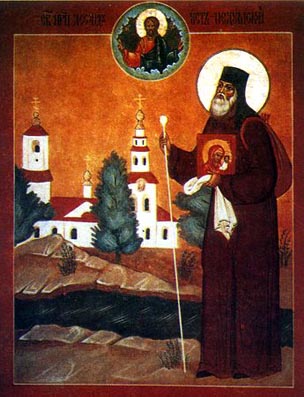
The Monk Leonid of Ust'nedumsk
Commemorated on July 17
The Monk Leonid of Ust'nedumsk lived in the Poshekhonsk district of the Vologda outskirts, and he was a farmer by occupation. At age fifty, he saw in a dream the Mother of God, Who directed him to go to the River Dvina to the Morzhevsk Nikolaev wilderness-monastery, to take there the Hodegetria Icon of the Mother of God, and at the River Luza and Mount Turin build a church. The Monk Leonid decided not to follow the advice of this vision, thinking it but simply a dream. He went off to the Kozheezersk monastery, accepting monasticism there and spending about three years at work and monastic efforts. From there the monk transferred to the Solovetsk monastery and toiled there in the bakery. The miraculous dream-vision was repeated. The Monk Leonid thereupon set off to the Morzhevsk wilderness-monastery, and after a year he told the monastery-head Kornilii (1599-1623) about the command of the Mother of God. Having received from the monastery-head both a blessing and the Hodegetria icon, the monk reached the River Luza near the Turin Mount, 80 versts from the city of Ustiug, and he built himself an hut from brushwood. But some not so good people compelled him to resettle up along the river, in a marshy wilderness spot. At 30 versts from the city of Lal'sk the elder constructed a cell and set about the building of a monastery. For drawing down the marshes, the ascetic dug out three canals, in length about 2 kilometers, – from the River Luza to Chernoe Ozero ("Black Lake"), and from Chernoe Ozero to Svyatoe Ozero ("Holy Lake"), and from there to the to the Chernaya-Black Rivulet. During this time of heavy work he was bitten by poisonous vipers. Consigning himself to the will of God, the Monk Leonid decided not to take any sort of measures of treatment nor did he think of the consequences – and he remained healthy. In gratitude to the Lord for His mercy, he called the canal the "Nedumaya Reka" ("Unplanned River"), and his monastery – the "Ust'nedumsk" (the "Nedumaya-mouth") monastery.

With the blessing of
the Rostov Metropolitan Philaret (afterwards the All-Russia Patriarch,
1619-1633), the Monk Leonid in 1608 was ordained priest-monk. In the
newly-erected church in honour of the Vvedenie-Entrance into the Temple of the
Most Holy Mother of God, Priest-monk Leonid installed the Hodegetria icon, as
commanded him by the Mother of God. By his not so easy efforts on the frontier,
called the "Luzsk Permtsa", which means "the pocket-land of the
wild Permians", God's saint merited rightful veneration as one of the
first enlighteners of these remote lands.
The monk had many a
struggle with the severe and inhospitable forces of nature. Although his
canal-system had drained the marsh, in times of floodings the River Luza
overflowed the wilderness-monastery. Towards the end of his life the tireless
toiler undertook construction on a point of land at Chernoe-Black Lake. At the
new locale was likewise erected a church, consecrated in 1652. The Monk Leonid
died at age 100, on 17 July 1654. He was buried at the monastery
Vvedenie-Entrance church – where for a long time they preserved his coarse and
heavy hair-shirt – a reminder of the ascetic toils of the holy saint.
They have a tropar to
the Monk Leonid, and his holy icons are in churches at the places of his
toilings.
© 1996-2001 by translator Fr. S. Janos.